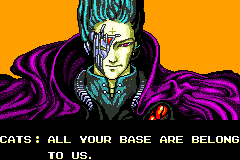cs498gd:game_design_principles_and_game_genres
Table of Contents
Game Design Principles and Game Genres
Motivation: Why Do We Love Pong?
- or “Why might some people have loved pong when it was first introduced?”
- Simple
- Every game is unique
- Elegant representation (of table tennis in real life)
- Social – it takes two to play
- Fun (at the time)
- Cool, novel (at the time)
What is a Game?
- Differences between a movie and a game
- A movie does not require any user input; a game does.
- A movie has a predetermined ending; a game sometimes has no ending, sometimes can have one ending, sometimes can have multiple endings.
- Differences between a toy and a game
- A game has rules and goals.
- There may be constraints in a game.
- A game has a universe.
- Players
- Objects (e.g., vehicles)
- Terrains
- Behaviors, e.g., physics, sound, speech, emotions
What is a Digital Game?
- Interactivity
- Narrow input and output
- Information storage and manipulation
- Automation of complex systems (e.g., graphics, AI)
- Network communications
- Integration of all of the above
Game Design Principles
- “Why should someone else play it?” or “Why would someone else want to play this game I'm designing?”
- Identify players and audience.
- Identify genre, which may automatically place constraints on your game.
- Identify the universe or landscape.
- Identify the constraints and goals.
- Determine the criteria for success.
- How do you win/lose?
- Determine the rules of interaction.
- Controls; interaction with player-character.
- How do you explain constraints to the player?
- Do you tell a story?
Common Goals in Games
- Beat the final boss.
- Save the princess.
- Capture the king, the country, flag, etc.
- Save the world.
- Beat your opponent, the other guy.
- Get the highest score.
- Complete all the levels.
- Build the best {something} without going bankrupt.
- Sandboxing; play God/Deity (e.g. Black & White, Minecraft, Dwarf Fortress)
- Achieve something.
- Grab a lot of loot.
- Get the most kills.
- Kill everything that moves.
- Be the last man standing.
- Don't die.
- Beat the clock; don't run out of time.
- Character building.
- Build relationships.
- Solve a puzzle.
- Level up.
- Make the right choices.
Designing the Gameplay
- The game must have some elements of “fun” to be a good game.
- Some skill or strategy involved
- Feeling of accomplishment
- Immersion: Game allows you to live a different life, or be something that you wish you were.
- Anticipation: Do I look forward to playing this? Can this pass time? Sometimes addictive.
- Replay value (Super Smash Bros. – “Somehow never gets old.”)
- A good story, believable story
- Good production
- Real-world feel (e.g. realistic physics)
- Bug-free
- At least give me a chance (not too difficult)
- Reasonable learning curve
- Some variety in gameplay
- Not too linear (more open-ended, allow world/object exploration)
- Game balance
- Competition (multi-player)
Game Mechanics
- Defined by:
- Game space (world, landscape, arena, etc.)
- Objects, attributes, and states
- Actions
- Rules
- Skill
- Chance
Game Balance
- Defined by:
- Fairness (start symmetrical – equal resources and powers to all)
- Challenges vs. success
- Meaningful choices: low risk-low reward, high risk-high reward
- Short vs. long (game or game level length)
- Rewards (level up, gain items, etc.)
- Punishment (level down, lose items, etc.)
Game Design and Gameplay Blunders
- Formulaic, unoriginal
- Level-up, level-down, power-up, 1-up, blah
- Very flat, linear gameplay
- Incorrect facts
- Bad physics
- Unfinished or rushed game.
- Overworked developers
- Bad testing; bugs galore
- Doesn't sell well.
- Players get angry.
- Patch / update hell.
- I need the CD to play this game? (DRM)
- Unrealistic, ludicrous storyline
- Movies/cutscenes that can't be skipped
- Bad camera control
- Bad AI
- Repetition, no variety
- Inability to save
- “I don't know what to do”; lack of feedback
- Clunky user interface
- Too much emphasis on sound, graphics
- Bad sequel
- Bad customer support
- Poor lighting
- Bad port
- Poor performance; game crashes
Game Genres
- Classifications of digital game features
- Describe the style of the game
- Problems:
- Most games fit into multiple genres
- The list of genres can go on forever (see below)
- No standard; some controversy over whether there should be standards
- Importance of genres: Sets expectations
- For players: They know what to expect in the game.
- For developers: They have to adhere to certain design patterns (sometimes known as the “unwritten rules”) of the genre.
- See “formulaic” above.
List of Genres
- Strategy
- First-Person Shooter (FPS)
- Real-Time Strategy (RTS)
- MMORPG
- RPG
- Adventure
- Action
- Simulation
- Sports
- Racing
- Shoot 'Em Ups / Beat 'Em Ups / Blow 'Em Ups
- Sidescrolling
- Brawlers
- Fighting
- Puzzle
- Party
- God/Deity Games
- Sandbox
- Music/Rhythm
- Space Shooter
- 2D Space
- Movie-Based / Full-Motion Video
- Historical
- Education / Edutainment
- Simulation
- Stealth
- Interactive Fiction
- Text
- Dungeon crawl, rogue-like
- Procedurally Generated Content
- Horror
- Bullet Hell
- …
Genre: 2D Space (Shoot 'Em Ups; Arcade)
- Examples: Space Invaders, Asteroids, R-Type, Defender, Tyrian
- Spurred arcade boom in the '80s
- Relatively easy to develop
- Problems: unrewarding; stale; not a good sell anymore
Genre: Simulation
- Examples: Sims, SimCity, Flight Simulators, sports games
- Mimics real-world scenarios, including physics, atmosphere, and limitations
Genre: Massively Multiplayer Online Role Playing Games (MMORPGs)
- Examples: League of Legends, World of Warcraft, Everquest, City of Heroes, City of Villians, Maple Story, Minecraft (?)
- Descendant of interactive fiction and Multi-User Dungeons (MUDs)
- Popularly subscription-based for revenue stream
- Character-building
- Requires computer networking
- Problems: software patches; out-of-game economies; addiction; can have lots of mundane and boring tasks
Lab Activity: Game Analysis (Assignment 1)
- Deadline: Sunday, 9/18/2016, 11:59pm
- Purpose: Analyze the design of an interactive system
- Introduction
- Flauncy Space Cows is a student-created game.
- Instructions
- Download the game jar file.
- Follow instructions to run the game and extract contents from the jar file.
- (If in the Linux lab) Run with this command:
- $ java -jar flauncy.jar
- (If in the Linux lab) Unzip the contents of the jar file with this command:
- $ mkdir flauncy; unzip flauncy.jar -d flauncy
- Play the game for at least 20 minutes. Also play in the 2-player mode. You are to analyze the design of the game by play-testing and examining the contents of the game jar archive.
- Answer the following questions to the best of your ability in a plain text file,
flauncy_analysis.txt. One sentence answers will earn a bad grade. Dropboxflauncy_analysis.txton ecampus.
1. Describe your interactive experience. Is
the game enjoyable, frustrating,
impossible, ...?
2. List all the objects in the game.
3. Describe the game balance.
4. Describe the rules of the game.
5. What changes could make the game better?
- Additional info: See the game design document for Flauncy Space Cows.
cs498gd/game_design_principles_and_game_genres.txt · Last modified: by jchung





